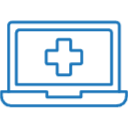Telehealth consultations are ideally suited for:
- Corona virus advice
- Patients self isolating requiring medical advice
- General medical advice, minor illnesses, stable chronic conditions
- Prescriptions, referrals & medical certificates
Rapid advances in information technology and increasing internet speeds have combined to act as a catalyst for the adoption of a range of digital based healthcare services in Melbourne and around the world. This new, alternate method of delivery has been called telehealth and it is helping make healthcare more accessible, faster, better and cheaper for different groups of people.
There is a common misconception that the terms telemedicine and telehealth are interchangeable, probably because they sound the same or because they seem similar at first glance. In fact, they are totally different and each refer to a different way to administer health care services.
As an all-encompassing term, telehealth is defined by the international organisation for standardisation as the ‘use of telecommunication techniques for the purpose of providing telemedicine, medical education, and health education over a distance’. As such, it includes health education services, remote monitoring of vital signs, ECG and blog pressure through wearable technology and remote doctor-patient consultations via telecommunications.
The biggest, best and most obvious feature of telehealth is its ability to connect people with health services anywhere, anytime. For people with low levels of personal mobility including expectant and new mothers, elderly people and those that live in regional, rural and remote areas, telehealth has been a life changing development in healthcare services.
For women growing tiny humans inside of them, with telehealth they can now be monitored and undergo regular check ups from the comfort of their own home. Expectant mothers can have better control over their pregnancy through the collection of data and access to medical information. This data can easily be shared with doctors, midwives and specialists allowing for more well-informed decisions, and better diagnosis meaning it is easier for healthcare providers to detect any possible issues in advance. This is particularly useful for women with high-risk pregnancies, meaning they are able to avoid unnecessary duress.
More accessibility to telehealth services will allow the increasing aging population to actively manage their health. Statistically, seniors are more likely to experience conditions that require routine monitoring such as diabetes, heart disease and cancer which are illnesses that require constant monitoring by providers. This lowers chances of hospital submission through the ability to detect developing issues early and helps to relieve stress levels of caregivers by giving them extra peace of mind that their patients and loved ones are monitored. The fact that this can be done remotely also eliminates the need for constant in-person visits, which can be costly and difficult for people with low mobility and limited access to transportation. But if in-person visits is a must then you must wear gowns for your safety precautions to the hospital you’re having check-up with.
Gone are the days of driving hours to access appropriate health services. Telehealth enables people residing in regional and remote towns to have access to doctors and specialists instantly via video conferencing. Not only that, it is also used as a tool for pre and post-operative care, help rural doctors seek second opinions for their patients quickly and efficiently, helps manage emergencies and also gives staff access to remote education, training and support on location.
A broad range of medical specialities in Australia is already involved in the delivery of medical care by way of telehealth.To find out more about the services we offer, book a consultation with one of our expert Southbank Doctors or call 03 9690 1433 and contact us today.
Our Services
We bring a high level of commitment and excellence to our healthcare services.
